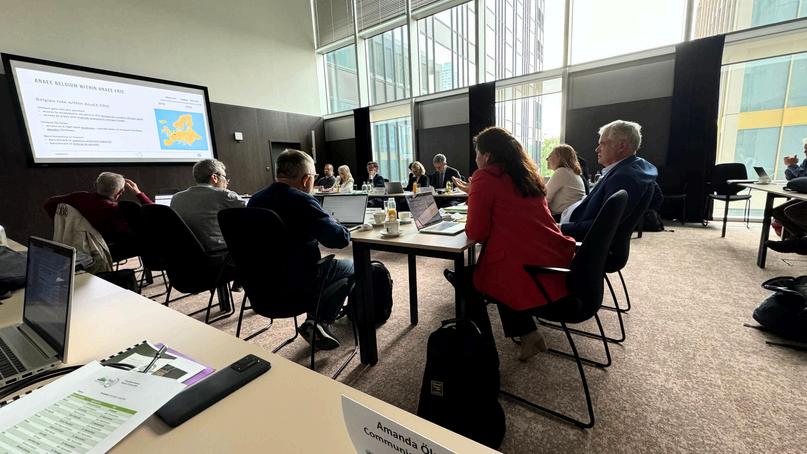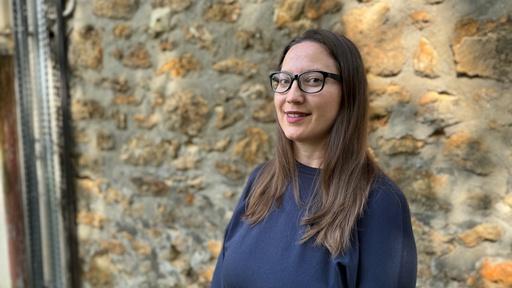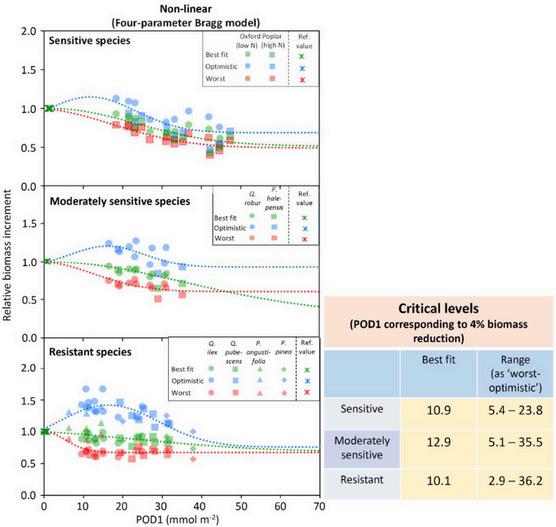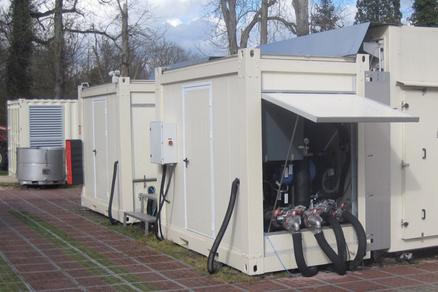
A N A E EE R I C PAGE 6 PAGE 7-8
NEW TEAM MEMBERS N E W S L E T T E R : : S U M M E R 2 0 2 4
COMBATTING FOREST FIRES AND URBAN HEAT - ELENA ORMENO
PAGE 1
FOREWORDS
PAGE 2-4
NEWSANDUPDATES
PAGE 5 CALLSANDEVENTS
PAGE 6 NEWTEAMMEMBERS
PAGE 7-8
INTERVIEW-DRELENAORMENO
PAGE 9-11
NEWSFROMOURNATIONALNODES
PAGE 12-14
INTHEJOURNALS
FOREWORDS
Dearreader,
Just in time for your summer holiday you have in your hands the new issue of our quarterly newsletter
The main event of the period has been the meeting of our Assembly of Members (AoM), June 12 & 13 in Brussels. This is our highest body that takes strategic decisions on all aspects of the life of AnaEE-ERIC Members are

represented at the ministerial level, as AnaEE-ERIC is an intergovernmental organization.
The 5th AoM approved the 2023 activity report which is now available on our web site It discussed also several issues on the access to the Research Infrastructure and presented the way we will work on the updated strategy AnaEE Belgium presented its installations and the wealth of research performed using its services. The AoM was impressed by the dynamism, quality of network, dedication of teams, and cutting-edge research results.
You will read many news in this issue about the activity of AnaEE during the last months I will finish this foreword by advertising our AnaEE 2024 conference that will take place in Paris, 8 - 10 October This is a unique opportunity to exchange on hot topics in ecosystem science and how to use AnaEE services for your research.
Michel Boër
ABOUT ANAEE-ERIC
Keeping agricultural, forest and aquatic ecosystems productive is a key issue for the future of the planet. To safeguard the services provided by ecosystems and to develop a sustainable bioeconomy, scientific knowledge is needed on how climate change, biodiversity loss and change of land use affect our ecosystems
AnaEE-ERIC (Analysis and Experimentation on Ecosystems) is a distributed research infrastructure that offers a network of experimental facilities across Europe, equipped with advanced tools for conducting experiments and collecting data on how ecosystems respond to changes like climate change.
We also provide industry and the agricultural community with valuable resources, expertise, and collaboration opportunities to address environmental challenges, drive innovation, and promote sustainable development
AnaEE-ERIC is founded by eight members: 6 members countries (France, Denmark, Italy, Czech Republic, Finland, Bulgaria), 1 Observer (Belgium) and 1 International Organization (CIHEAM)

CONTENTS
1 | ANAEE _ ERIC
ANAEE-ERIC NEWS AND UPDATES
AQUASERVKICK-OFF
Faro,April
The project AQUASERV held its kick-off meeting in Portugal in April
The goal is to drive the implementation of the European Common Fisheries Policy, the Farm to Fork Strategy, the Sustainable Blue Economy, and the European Green Deal Three AnaEE-ERIC installations from our Finnish and French national nodes offers TA/ VA via AquaServ.
IRISCCKICK-OFF
Helsinki,June
The project IRISCC held its kick-off meeting in Finland in June IRISCC provides scientific and knowledge services to foster cutting-edge research and evidence-based policymaking to improve Europe's resilience to climate change AnaEE-ERIC contributes with three of its affiliated in Finland, Denmark and Bulgaria.
THREENEWTEAMMEMBERS
Two new colleagues have started their positions in our Interface and Synthesis Centre, in Czech Republic
Dr. BiljanaĐorđević takes the role of our Scientific Officer. Dr. OgheneyomaOlisahis our EU project Manager and liaison Officer More about them on page 5 YoussefHaidala is our new IT engineer and has joined the team in the Central Hub in Gif-surYvette, France. We will get to know him better in the autumn issue of the newsletter
ANAEE-ERIC’S5THASSEMBLYOFMEMBERS


ERIC scientific talks that was launched this spring and will be open to the public in autumn
Brussels,June
The fifth Assembly of Members of AnaEE-ERIC took place in Brussels. The AoM approved the activity and financial reports for 2023 which are now available on our website The assembly also discussed the access to the services provided by the AnaEE network of facilities, our core mission, and the preparation of the mid- and long-term strategy of AnaEE.
Our Belgium Node presented their latest updates and gave an insight in their coming developments, such as the ME-RAU - mobile rapid assessment Ecotron units that will allow fast and targeted experimentation currently being installed Among other things the importance of project participation through the network, for developing new technology and methods.
The meeting was well attended, with 24 people present, including AnaEE-ERIC staff, experts, and delegates.
ANAEE _ ERIC | 2
The AnaEE-ERIC team visiting the premises in Saint-Pierre-lès-Nemours, south of Paris
The Assembly of Members in Brussels June 2024
AnaEE-ERICscience conference2024
AnaEE-ERIC will host the conference Ecosystems underpressure with the 2024 theme: "Theroleof experimentation"
Time:October8-10th
Place:Paris,France
REGISTRATION ON ANAEE
WEBSITE OR QR-CODE

ANAEE2024.SCIENCESCONF.ORG
OTHER CLIMATE NEWS
NEWSBITES
NEWENVIRONMENTALCRIMEDIRECTIVES has come into force The law provides a comprehensive and up-to-date list of environmental offences addressing the most serious breaches of environmental obligations
”THEAGEOFFOOLS”
Almost 80% of respondents from the Intergovernmental Panel on Climate Change, expect global temperatures to rise to at least 2 5°C above pre-industrial levels this century, according to a survey by The Guardian
Almost half are concerned that temperatures would rise to at least 3°C, with only 6% thinking the internationally agreed 1.5°C limit would be possible. The survey also concluded that the climate scientist’s overwhelming feelings were fear and frustration.
In the article, Camille Parmesan a researcher at the CNRS ecology centre in France, was on the point of giving up 15 years ago. “I had devoted my research life to [climate science] and it had not made a damn bit of difference,” she said. “I started feeling [like], well, I love singing, maybe I’ll become a nightclub singer.” She was inspired to continue by the dedication she saw in the young activists at the turbulent UN climate summit in Copenhagen 2009. “All these young people were so charged up, so impassioned. So I said I’ll keep doing this, not for the politicians, but for you ”
REWILDINGTOCUTEMISSIONS
A herd of 170 bison reintroduced to Romania’s Țarcu mountains couldhelpstoreCO₂ emissions equivalent to removing 43,000 US cars from the road for a year, research has found, demonstrating how the animals can help mitigate some effects of the climate crisis
PUBLICATIONSONCLIMATE
Bioeconomy Globalization: Recent trends and drivers of national programs and policies
The bioeconomy holds promise in reducing dependence on fossil fuels, addressing climate change, and promoting resource efficiency, thereby stimulating economic growth, innovation, and improving food security. In 2020, the International Advisory Council on Global Bioeconomy (IACGB) released a comprehensive report that analyzed the progress of bioeconomy policies across the globe up until that year. This study builds on that report, analyzing bioeconomy policy trends between 2020 and 2024 The study aims to contribute valuable insights for policymakers, researchers, and other stakeholders involved in shaping the evolving bioeconomy landscape.
European Climate Risk Assessment
The EUCRA report builds on and complements the existing knowledge base on climate impacts and risks for Europe, including recent reports by the Intergovernmental Panel on Climate Change, the Copernicus Climate Change Service and the Joint Research Centre of the European Commission, as well as outcomes of EU-funded research and development projects and national climate risk assessments The knowledge in this first-of-its-kind assessment is synthesised with the aim to support strategic policymaking
In May 2024, the European Commission, assisted by the World Bank, published 3 new reports on how to invest in disaster resilience, the cost of adaptation strategies and the financial impact of wildfires and droughts
ANAEE _ ERIC | 4
CALLS AND EVENTS
CALLID
calls open for submissions
PillarII-Cluster6:Food,Bioeconomy,NaturalResources,AgricultureandEnvironment
Closingdate Title
HORIZON-CL6-2024-CLIMATE-02-1 24/09/24
HORIZON-CL6-2024-CLIMATE-02-3 24/09/24
HORIZON-CL6-2024-FARM2FORK-03-1 24/09/24
HORIZON-CL6-2024-CLIMATE-02-2 24/09/24
NationalDanishroadmapforRIs October2024
New knowledge and innovations for climate-smart farming - connecting research stations
Overcomingbarriersanddeliveringinnovativesolutionstoenablethegreentransition
Spotlightonplantprioritypest:fallarmyworm(Spodopterafrugiperda)
Closing the research gaps on Essential Biogeochemical Ocean Variables (EOVs) in supportofglobalassessments
Nationalcalls
The purpose is to identify the nationally and strategically most important proposals for RIsembeddedinbroadinstitutionalpartnerships.Clickhereformoreinfo. 2ndCalloftheGreenERAHub 31/07/24 Cropandlivestockfarmingmeetingthechallengesofclimatechange
EVENTS & meetings
European Association of Environmental and Resource Economists (EAERE) 1-4 Jul, Leuven, Belgium
Discusses environmental and resource economics.
14th European Conference on Ecological Restoration (SERE) 26-30 Aug, Tartu, Estonia
Bridging Science, Practice, and Policy of Nature Restoration
AnaEE-France 4th Summer School: Machine learning in ecology 23-27 Sept, The Lautaret Garden, France
Int. Conference on Sustainable Energy and Environmental Protection (SEEP) 9-12 Sept, Vienna, Austria Covers sustainable energy and environmental protection technologies
Int. Conference on Sustainable Development (ICSD) 19-21 Sept, Rome, Italy Promotes sustainable development research and practices.
5 | ANAEE _ ERIC
NEW TEAM MEMBERS
DR.BILJANAĐORĐEVIĆ-SCIENTIFICOFFICE
BeforejoiningAnaEE-ERIC,Iwasworkingontheassista positioninForestProtectionandWildlifeManagementD FacultyofForestryandWoodTechnologyandasarese andheadofplantbiotechnologylaboratoryatPlantbiol Department,FacultyofAgriSciences,bothatMendelU Brno,CzechRepublic
Myresearchinterestwasorientedtowardsplantbiotec physiologyandtheeffectofbioticandabioticstressonp g Withover15yearsofexperienceinmanagingandconducting complex and advanced research projects, I am eager to bring this expertise to my role at AnaEE-ERIC


In my spare time, I have a deep passion for activities that connect me with nature I enjoy spending time in my garden and to take walks in the forest, observing wildlife, and studying different plant species I also love reading, especially books related to botany, environmental science, and nature conservation
As a Scientific Officer at AnaEE-ERIC, the most exciting part is engaging in interdisciplinary research and synthesizing complex scientific data Collaborating with the Director General, staff, node coordinators, and scientists from various disciplines broadens my perspective and enriches research outputs The diverse responsibilities, collaborative environment, and potential to make a significant impact on society through science make this role particularly exciting and fulfilling for me

DR.OGHENEYOMAOLISAH-EUPROJECTMANAGERAND LIAISONOFFICER

Iworkedasascientistforvariousorganizationsinresearchand industryforoveradecade Iwasinvolvedininternationalprojects focusingonfoodproductdevelopmentandregulatorycompliance amongotherareas.Idevelopedprojects,plannedbudgets,and ensuredtimelyprojectdelivery Icollaboratedwithgovernment agencies,NGOs,researchers,andindustrypartnersinNigeria,UK,and SouthAfrica.
Ilovewalkinginparkswithmyfamily,eatingnewfoodsandmeeting newpeople Exploringnatureandconnectingwithnewpeople
enhances my learning and creativity. I also enjoy exercising as this revitalises my mind and body.
I am excited to manage cross-disciplinary projects focused on innovative ecosystem management solutions This role allows me to significantly impact environmental policy and conservation, which are vital for sustainable economic development Collaborating with the ecosystem community and researchers to use cutting-edge technology to address real-world challenges makes this opportunity particularly thrilling
ANAEE _ ERIC | 6
COMBATTING FOREST FIRES, AIR POLLUTION AND URBAN HEAT
ELENA ORMENO’S CALL FOR DIVERSITY AND INTERDISCIPLINARITY
Elena Ormeno’s research centers on understanding how forests get adapted to global change through production of numerous chemical defenses that are partly emitted but also stored in plant organs - eventually increasing plant flammability. The emissions are called biogenic volatile organic compounds (BVOCs) which participate in the formation of ground-level ozone and secondary organic aerosols (SOAs) after they have undergone complex chemical reactions with nitrogen oxides (NO, NO₂, released from traffic pollution mainly) under light conditions
This is not just an academic exercise; it has profound implications for air quality and climate regulation at global scale, and also affects urban spaces since BVOCs are highly flammable compounds.
When Elena began her PhD, the study of plant volatile defenses was limited by the technology available. Data collection was manual and at low-time resolution However, the early 2000s saw the advent of Proton Transfer Reaction Mass Spectrometry (PTR-MS), a groundbreaking tool that allowed for continuous, highresolution monitoring of BVOCs.
- During my PhD, we collected data manually once every hour. Now, we collect them every second, day and night, and we check-up for emissions during the field campaign, Elena explains
THE HIDDEN
CONTRIBUTORS TO AIR QUALITY AND CLIMATE REGULATION
This technological leap has enabled researchers to observe and understand plant responses to environmental stress in real time
AJOURNEYTHROUGHDIVERSEECOSYSTEMS
Elena’s career has taken her from studying natural ecosystems in Europe to agrosystems in California at the University of Berkeley, with a focus on canopy and litter (leaves decomposing on siol), and even to examining BVOCs released by bacteria essential for plant growth Her work at CNRS in France since 2010 has focused on the long-term impacts of environmental stressors on BVOC emissions and other plant defenses
Elena’s work has broad applications. By studying the sources (canopy, litter) of biogenic VOC, the factors that modulate their emission and by identifying the major BVOC emitters, we can better manage air quality, mitigate the associated health risks and prevent fire intensity, both in natural ecosystems and in the wildland-urban interfaces where fire risk has dramatically increased
In cities and peri-urban spaces,it is well known that O3 regulation cannot be achieved by limiting NOx production from traffic alone. Instead, both NOx and VOC regulation are required
In the lush expanses of our forests, a silent yet powerful interaction is taking place Forests emit biogenic volatile organic compounds (BVOCs), like isoprene and monoterpenes into the atmosphere. The BVOC also prolongs the life-time of methane, and their degradation in the atmosphere leads to CO₂ formation.
By understanding how BVOCs contribute to ozone formation, we can better manage air quality and mitigate health risks associated with air pollution
This emission is not just a benign natural process; it has significant implications for air quality and climate regulation.

DR.ELENAORMENO ResearchScientistatCNRSand IMBE(CNRS/AMU) ScientificDirectoroftheAnaEE-Francefacility O3HP(OakObservatory)
WHO?
This is of special relevance in the current context of urban greening in major cities where planting plant species with a major capacity to release BVOCs could be detrimental for air quality in terms of O₃ and aerosol formation
Additionally, aerosols formed from these compounds play a role in climate regulation by affecting cloud formation and sunlight scattering. This knowledge is crucial for developing accurate climate models.
THEROLEOFANAEE-ERIC
Elena credits AnaEE-ERIC, which offers the possibility of responding to numerous European calls targeting longterm research infrastructures These projects provide significant funding to maintain and homogenise longterm measurements in the network and connect with other ERIC networks
- This is crucial for us researchers. Changes in undisturbed, natural ecosystems don’t occur in the first five years but start after seven years on average and continue evolving. Permanent funding is vital for capturing these long-term trends, she says
Elena can’t pinpoint where her interest in science came from, but as a child she already spent her monthly allowance on subscriptions to scientific journals. Today, she emphasizes the importance of communicating scientific findings to the public and inspiring young people to pursue careers in science. She regularly gives talks in public schools and media to highlight the relevance of environmental research
BALANCINGURGENCYANDOPTIMISM
Despite the pressing nature of climate change, Elena remains optimistic, quite a rare approach when looking at the average response in the Guardian survey on climate scientists where the overwhelming feelings were fear and frustration
- I don't get anxious because I prefer to think there are still solutions or at least ways to mitigate the changes that are coming. When I give lectures, my mission is to educate people about the critical interactions in nature, the services different ecosystems provide and the importance of biodiversity to mitigate air quality and fire risk without adding to their anxiety, she says
Elena Ormeno’s work exemplifies how dedicated research can lead to a deeper understanding of complex environmental processes and inform strategies to address pressing ecological and public health challenges
Elena Ormeno's research extends to the critical issue of forest fires There is a paradoxical relationship: when
plants are stressed by heat and drought, they accumulate defence compounds, and these changes increase the risk of fires since many of them are flammable, increasing vegetation flammability. While some species thrive in fireprone environments, others suffer greatly
THESOLUTION:BIODIVERSITY
Elena advocates for biodiversity as a key strategy in managing forest fires and promoting resilient ecosystems.
- Mixing, mixing, mixing - it’s important in nature. Monocultures and clones are vulnerable to global change and associated pathogen damage, but diverse plantings can mitigate these risks. For instance, oak trees are less flammable than pine trees, making them a strategic choice in fire-prone areas By integrating a variety of species, we can create more fire-resistant landscapes, she says.
BRIDGINGKNOWLEDGEANDACTION
Elena emphasizes the importance of translating research into practical policies. She underscores the need for transdisciplinary collaboration for urban greening planning. This allows combining the socio-economical policy situation, such as budget, available areas, tree maintenance costs, and fundamental knowledge like plant structure, pest resistance, tree flammability and the tree’s capacity to release BVOC. This holistic approach ensures that the best combinations of species are selected for urban greening projects
Even if she often encounters frustrating political and administrative barriers that can hinder effective action she remains hopeful thanks to the growing societal awareness and demand for greener cities
The urgency of urban greening is particularly acute in Mediterranean cities like Marseille, which are becoming increasingly dry. Marseille is one of many cities that plans to get greener, and aims to double its trees to 300,000 within four years But considering that these are increasingly dry and hot areas it’s important to select a diversity of species well adapted to Mediterranean climate
ACALLTOACTION
Elena Ormeno’s work is a compelling reminder of the intricate links between ecology, climate, and human wellbeing Her advocacy for biodiversity, interdisciplinary collaboration, and informed policymaking is crucial for creating resilient and sustainable urban and natural environments
By bridging the gap between scientific research and practical application, she is helping to pave the way for greener, cooler, and more resistant socio-ecosystems.
ANAEE _ ERIC | 8
NEWSBYTES FROM OUR NATIONAL NODES
DENMARK

AnaEE Denmark is co-organizing a PhD summer course on measuring greenhouse gas exchange with chambers 26-30 August 2024. The deadline for signing up is first of August.
The course will focus on developing the skill set for post-graduate students in measuring and analyzing the exchange of GHG’s between the soil/ ecosystem and the atmosphere using newest chamber technologies.
Guest lecturers: JohannesW.M.Pullens is assistant Professor at Dept. of Agroecology at Aarhus University. He is involved in the AnaEE Denmark Research Infrastructure and works with both eddy covariance and chamber measurements to measure exchange of CO₂, N₂O and CH₄ of agrosystems. SanderBrunn(Assoc Prof.) and AzeemTariq(assist prof) from the Dept of Plant and Environmental Sciences at University of Copenhagen are also involved in AnaEE Denmark activities with measurements of GHG exchange in agricultural systems
BULGARIA

A three-year project "Innovative Method for Optimal Fertilization of Agricultural Crops" valuated the conditions of vegetaion in an enclosure and open-air platforms at Bojurishte and Tsalapitsa finished at 2024. The project was funded by the Bulgarian National Science Fund (BNSF) of Bulgarian Ministry of Education and Science.
An analysis of the results of the pot and field experiments with applied fertilization was carried out Variance and regression analysis of experimental data was performed New parameters were obtained for characterizing the agrochemical properties of soils and their relationships with crop yield
A new approach was to the optimization of major nutritional elements with linear and intrinsically non-linear mathematical models is described (nitrogen, phosphorus, potassium and silicon) The action and interaction between the nutritional elements under different soil conditions has been optimized using global databases with open access; Fuzzy set methods were used to establish tolerance limits when fertilizing with different macro-, meso- and micro-elements
The most important result an innovative method for optimal fertilization of agricultural crops An application for a patent for an invention has been submitted to the Patent Office of the Republic of Bulgaria with the name "METHOD FOR OPTIMAL FERTILIZATION OF AGRICULTURAL CROPS".
The main results were presented at the International Conference “Closed Cycles and the Circular Society 2023: The power of ecological engineering” of the International Ecological Engineering Society (IEES), October 1st – 5th, 2023 in Platanias – Chania on the island of Crete, Greece.

Assist Prof Iliyana Gerasimova presenting project results on the conference “Closed Cycles and the Circular Society 2023: The power of ecological engineering” of the IEES, October 1– 5 2023 in Platanias – Chania on the island of Crete, Greece
9 | ANAEE _ ERIC
FINLAND

President of Finland Alexander Stubb visited Utsjoki on Thursday 23 May 2024. The programme included a visit to the activities and research areas of the Lapland Research Institute Kevo and discussions with representatives of Metsähallitus.
Station manager Otso Suominen told the President about the long-term environmental monitoring carried out at the Kevo research station. Long-term time series are necessary for observing environmental changes, adapting to them and predicting their consequences The oldest monitoring at the station, dating back to the 1970s, focuses on plants and butterflies, while the most recent monitoring concerns bats and ticks The mapping of the flora of Inari Lapland started in the 1950s, before the station was established
President Stubb's last visit was to the new monitoring system of EcoClimate, an experimental environmental manipulation platform The platform makes use of the extensive fencing experiment established in 1968
A fibre-optic link has been installed at the experimental site, so that measurements can be automatically collected directly from the field. The permanent measurements will be supplemented by various shorter-term measurement campaigns. The long-established meteorological station of the Finnish Meteorological Institute in Kevo provides significant added value to the project.
CIHEAM

In 2023, the geomatics laboratory at CIHEAM Bari made significant progress in research by introducing new technologies and expanding their inventory of tools and equipment
One of the most notable advancements was the development of an advanced algorithm for analyzing satellite images from the Copernicus Sentinel program.
This algorithm can monitor crop changes caused by diseases, classify cropping systems and soils, and analyze large-scale agroecosystems Its functionalities also include estimating agronomic parameters and detecting abiotic and biotic stress conditions in crops, which are essential tools for optimizing the management of agricultural resources.
The laboratory also developed a phytosanitary treatment system for vines, which can be managed remotely and is designed for the nebulization of hydrogen peroxide inside covered tents. This innovation aims to prevent plant diseases while reducing the use of plant protection products, a crucial step towards more sustainable agricultural practices.
ITALY

The FO3X facility has started another year of research, with over six plant species set to be exposed to tropospheric ozone (O₃) fumigation
A recent study at the facility reviewed the influence of O₃ on plant biomass yield, proposing a novel approach to identify relative O₃ risks with prediction limits considering best, optimistic, and worst-case scenarios which has been published (See the journals)
In another study, researchers discovered a nonlinear dose-response relationship, revealing that critical O₃ exposure levels significantly affect carbon gain and biomass growth in date palms (link) In another study, the biochemical responses of young leaves of poplar clones revealed age-specific impacts of O₃ on reactive oxygen species (ROS) production, highlighting the need for age-specific strategies in managing O₃ stress (link).
These studies underscore the critical role of FACE facilities in advancing our understanding of ozone's impacts on various plant species. They provide precise, real-world data essential for developing effective mitigation strategies.
ANAEE _ ERIC | 10
FRANCE

This year, AnaEE France completes a 5-year period of funding by the French National Research Agency. The activities of the French infrastructure have enabled us to attract an average of 300 projects each year since 2019, involving around 1,000 users, with 10-15% of them international and 5-10% from the private sector There have been 1,500 data and sample requests, the production of over 170 articles, and training and communication initiatives involving an average of 2,000 people, with 500 receiving technical training
AnaEE France has recently been approved for new funding for the period 2025-2030, focusing on upgrading, rejuvenating and purchasing new technologies for analysis and experimentation
AnaEE France Annual General Meeting was held from March 18 to 20, gathering approximately 80 participants, including members of the infrastructure, representatives of supervisory bodies, partners and funders. A series of workshops titled "AnaEE ERIC, FAIR data management solutions, 'open air' services, scientific and technical foresight, and sample management," provided an opportunity to discuss topics chosen by the community and the infrastructure coordination.
BELGIUM

AnaEE Flanders subnode of AneEE Belgium has submitted a proposal to the national funding system for Belgium to become a full member of AnaEE A decision is expected by December 2024
Hasselt University Ecotron works on installation of a root monitoring system, rhizotrons, which will allow assessments of environmental change on root developments within the ecotron units. The project is conducted by a PhD student Vera Claessens, in collaboration with LUKE (AnaEE Finland). As such the rhizotron installation project at Hasselt Ecotron constitutes a part of PHENET project, where AnaEE is a participant. Find out more about Ecotron of Hasselt University: https://www.uhasselt.be/en/ instituten-en/cmk-centre-for-environmentalsciences/infrastructure/ecotron
UAntwerpen Mesodrome is running on full force this time of the year with not less than 9 different experiments running at the same time, including: inundation of oaks to test their water stress, testing the effects of heatwaves on entire aquatic ecosystems and experiments to measure the devastating effects of invasive crabs on native aquatic vegetation, to name just a few
11 | ANAEE _ ERIC
IN THE JOURNALS
ANAEE-ERICPLATFORMSFORCLIMATERESEARCH
READINGTEALEAVESWORLDWIDE:DECOUPLED DRIVERSOFINITIALLITTERDECOMPOSITIONMASSLOSSRATEANDSTABILIZATION
The breakdown of plant material is vital for soil health and biodiversity, but understanding global patterns is difficult due to a lack of large-scale data. We buried 36,000 tea bags worldwide and found that faster initial mass loss generally led to less stable carbon, using the Tea Bag Index (TBI) However, in colder areas, agriculture and climate factors affected this relationship. TBI provided better decomposition estimates than models ignoring stabilization Ignoring early-stage changes in plant material can lead to overestimating carbon loss in climate models.
First published: 07/05/2024
Sarneel et al.
Ecology Letters Doi: 10 1111/ele 14415

Facility: Brandbjerg (CLIMAITE)
Contact: Klaus Steenberg Larsen ksl@ign ku dk

Facility: FATI-UAntwerp
Contact: Dr. Hans De Boeck hans deboeck@uantwerpen be Tel 032651714
DOESPREVIOUSEXPOSURETOEXTREMEPRECIPITATION REGIMESRESULTINACCLIMATEDGRASSLAND COMMUNITIES?
Climate change is expected to increase weather persistence in mid-latitudes, leading to longer dry and wet periods than historical averages. This shift could significantly impact terrestrial ecosystems through more frequent and prolonged droughts and waterlogging
The long-term effects of different precipitation regimes (PR) on grassland communities were studied Communities were exposed to either extreme or normal PR in year 1 (Y1), followed by the same or opposite PR in year 2 (Y2) Extreme PR in Y1 reduced diversity but enhanced acclimation, increasing biomass and structural sugars in Y2 In contrast, plants exposed to normal PR in Y1 exhibited higher stress responses under extreme PR in Y2
Acclimation effects were most pronounced in dominant grasses,
indicating high phenotypical plasticity Additionally, Y2 drought intensity correlated with grass productivity and structural sugar content, suggesting responses to short-term soil water deficits influenced these patterns. Overall, more extreme PR is likely to alter diversity in the short to mid-term and favor acclimated grassland communities with increased productivity and reduced stress responses under future climate regimes.
First published: Sept 2022 S Reynaert et al Science of the Total Environment: https://doi.org/10.1016
ANAEE _ ERIC | 12

Figure:Exampleofflux-baseddose-response relationshipsfortheFO3Xfacilityconsideringa potentialrangeofreferencebiomass[RB].POD1 (PhytotoxicO3Dose)wasusedasaflux-based index Criticallevelswerecalculatedasthelevel causinga4%biomassreduction
Facility: FO3X (CNR/Italy)
Contact: Elena Paoletti elena paoletti@cnr it
Risk assessments of tropospheric ozone (O3) are critical for agriculture and forestry. Traditionally, these assessments use relative risks (RRs) based on biomass or yield at zero O3 dose, but estimating this zero-dose reference is difficult in Free-Air Controlled Exposure (FACE) facilities due to the lack of O3-free air treatments This study reviews current methods and introduces a "modified Paoletti's approach" to define RRs using biomass or yield data under FACE conditions.
It considers three scenarios: best fit, optimistic, and worst Findings show that O3-sensitive species have a narrower effect range than resistant species Additionally, the responses of moderately sensitive or resistant species are often non-linear, indicating that risk assessments should account for complex plant responses.
The study also recommends using tools like ethylenediurea treatments and mechanistic plant models to improve the accuracy of RRs against O3. This comprehensive approach helps better understand potential O3 risks and uncertainties based on species sensitivity
First published: Aug 2024. Yasutomo Hoshika et al. Environmental research. doi.org/10.1016/j.envres.2024.119215
THINNINGTURNEDBOREALFORESTTOATEMPORARYCARBON SOURCE-SHORTTERMEFFECTSOFPARTIALHARVESTON CARBONDIOXIDEANDWATERVAPORFLUXES
A study of the effects of deforestation after thinning on stand carbon exchange and waterlogging This study’s findings highlight the importance of considering both ecological factors and methodological approaches when studying forest responses to thinning practices in boreal ecosystems
Thinning did not change total evapotranspiration but altered its partitioning: transpiration and interception decreased, while forest floor evapotranspiration increased Inter-annual weather variability had little impact, allowing for robust thinning impact assessment The study highlights the importance of sub-canopy measurements and process-based models in understanding forest responses to thinning.

SMEAR II station from above
Photo: J.Aalto
Facility: SMEAR II
Contact: Pauliina Schiestl-Aalto pauliina.schiestl-aalto@helsinki.fi
First published: 15 June 2024. Toprak Aslan et al. Agricultural and Forest Meteorology: doi.org/10.1016/j.agrformet.2024.110061
OZONERISKASSESSMENTWITHFREE-AIRCONTROLLEDEXPOSURE (FACE)EXPERIMENTS:ACRITICALREVISIT
13 | ANAEE _ ERIC
INFLUENCEOFFERTILIZATIONONUPTAKEOFMACROELEMENTS WITHSUNFLOWERBIOMASS
The study examined how different rates of nitrogen, phosphorus, potassium, and silicon fertilizers affected nutrient uptake in sunflower biomass under pot experimental conditions using Alluvial-meadow soil There were 16 fertilizer variants tested in 3 replications
Data collected included yield of fresh and dry biomass and the content of N, P, K, Si, Ca, and Mg in the dry biomass. Results showed that fertilizer rates and combinations significantly influenced macronutrient content and uptake in sunflower biomass The highest nitrogen uptake was observed in variants with N200, N300, and N400 rates Increased fertilizer rates led to higher content and uptake of N, P, and Si, while the effect on potassium uptake was less pronounced
Published: 2023. GERASSIMOVA, Ilyana et al.
Journal of Central European Agriculture, 2023, 24(1), p. 236-244. DOI: /10.5513/JCEA01/24.1.3788

Facility: Ecotron Montpellier
Contact: Helene Lemoine helene.lemoine@ecotron.cnrs.fr

Facility: Bojurishte
Contact: Prof DSc Irena Atanassova i.d.atanassova@abv.bg
ADDITIVEEFFECTSOFBASALTENHANCEDWEATHERINGAND BIOCHARCO-APPLICATIONONCARBONSEQUESTRATION,SOIL NUTRIENTSTATUSANDPLANTPERFORMANCEINAMESOCOSM EXPERIMENT
Co-application of biochar and basalt for enhanced weathering resulted in additive carbon sequestration potentials Co-benefits for biomass, nutrient uptake and availability were predominantly additive, largely driven by basalt addition. Co-application did not reduce the increased plant uptake of potentially harmful trace elements.
Published: Aug 2024 Nicolas Honvault et al Applied Geochemistry: doi org/10 1016/j apgeochem 2024 106054
NON-TARGETEDSPECTRANOMICSFORTHEEARLYDETECTIONOF XYLELLAFASTIDIOSAINFECTIONINASYMPTOMATICOLIVETREES, CV.CELLINADINARDÒ
Olive quick decline syndrome (OQDS) has been severely affecting olive trees in southern Italy since around 2009. The disease, caused by the bacterium Xylella fastidiosa subsp. pauca, disrupts the tree's water and nutrient flow Early detection is difficult because infected trees initially show no symptoms In a study, young olive plants were artificially infected and analyzed, revealing specific changes in leaf chemistry that could help develop sensors for early disease detection
Published: 2023 Ahmed Elhussein et al. Molecules DOI: doi.org/10.3390/molecules28227512

Facility: Geomatics Laboratory Contact: Ivana Cavoski cavoski@iamb it
ANAEE _ ERIC | 14
AnaEE-ERIC is a distributed European-wide research infrastructure for experimental research on managed and unmanaged terrestrial and continental aquatic ecosystems


NATIONALNODECONTACTS
MEMBERS
Bulgaria:IrenaAtanassova(ISSAPPNP)
CIHEAM:Bari,ClaudioBogliotti(CIHEAM)
CzechRepublic:KarelKlem(CzechGlobe)
Denmark:KlausSteenbergLarsen(UniCopenhagen)
Finland:SädeVirkki(Luke)
France:Jean-FrançoisLeGaillardia,(CNRS)
Italy:ElenaPaoletti,(CNR)
OBSERVERS
Belgium,NadiaSoudzilovskaia(UniHasselt)
ANAEE-ERICCENTRES
CentralHub,France
MichelBoër
Dataandmodellingcentre,Italy
MarcoBascietto
InterfaceandSynthesisCentre,CzechRepublic
BiljanaĐorđević TechnologyCentre,Denmark
KlausSteinbergLarsen

Network of facilities

OPEN-AIRECOSYSTEMFACILITIES
Covervariouslanduses;Transect Europe’sclimaticzones

ENCLOSEDECOSYSTEMFACILITIES
Enableshigherlevelofenvironmental controlsandmeasurements

ANALYTICALFACILITIES
Performadvancedanalysesfordeeper insightandrobustconclusions

MODELLINGFACILITIES
Providemodelstoimproveanalysis; makereliablepredictions

BROWSETHE ANAEE-ERIC FACILITY CATALOGUE
ANAEE.EU


































